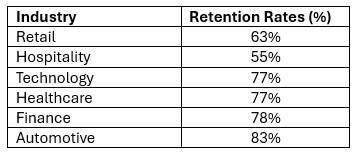Customer Retention Strategies Across Industries
In today’s competitive landscape, where customer acquisition costs continue to rise, businesses are increasingly recognizing the importance of customer retention as a cornerstone of sustainable growth. Regardless of the industry, retaining existing customers is more cost-effective and profitable than acquiring new ones. Understanding the vitality of customer retention is crucial for businesses to thrive in the long term. In this article we are going to be talking about 3 specific topics:
Understanding the Vitality of Customer Retention:
Customer retention goes beyond merely maintaining a customer base; it involves building lasting relationships that drive loyalty, advocacy, and repeat business. Retained customers are not only more likely to make repeat purchases but also tend to spend more over their lifetime value. Moreover, they can become brand ambassadors, referring friends and family and amplifying the brand’s reach through positive word-of-mouth.
Customer Retention Strategies & Percentage Norms By Industry:
While customer retention strategies may vary across industries, certain fundamental principles apply universally. From personalized experiences to loyalty programs and exceptional service, businesses employ various tactics to keep customers coming back. However, the percentage norms for customer retention can vary significantly from one industry to another. For instance, industries like subscription services or telecommunications may have higher retention rates compared to sectors like retail or hospitality. Understanding these industry-specific benchmarks can help businesses set realistic goals and tailor their strategies accordingly.
Comparing And Contrasting Strategies:
Despite industry differences, there are common threads that run through effective customer retention strategies. By comparing and contrasting strategies across industries, businesses can gain valuable insights into what works and what doesn’t. While the tactics may vary, the underlying goal remains the same: to deliver exceptional value, exceed customer expectations, and foster long-term relationships. Through benchmarking against industry peers and analyzing best practices, businesses can refine their retention strategies and stay ahead of the competition.
Let’s dive into it!!
Understanding the Vitality of Customer Retention
The core idea of customer retention serves as the distinguishing element in navigating the complex world of business and tells a captivating story of long-term success. Prior to diving into the strategies that are tailored to particular industries, it is critical to understand why customer retention is the unquestionable foundation for success in a variety of industries.
This knowledge provides the foundation for further investigation into the subtleties particular to each industry, enabling the creation of strategies that are in line with the requirements and dynamics of each one. To put it simply, understanding why customer retention is critical serves as a compass for companies as they navigate the many business terrains, making sure that the tapestry they create is not only vibrant and sturdy but also stands the test of time.
Sustained Revenue Streams:
Repeat Purchases: Customers who come back again and again play a big role in the money your business makes, even more than getting new customers. When they keep buying from you, it creates a steady income, making a strong base for financial success.
Exploration of Offerings: Loyal customers don’t stop at just one purchase; they’re likely to check out the other things your business offers. This curiosity can spark new ideas and lead to more products or services being bought, helping your business grow and bringing in more money.
Cost Efficiency in Retention:
Smart Spending: Getting new customers usually means spending a lot of money on things like ads and getting them started with your service. On the other hand, keeping the customers you already have doesn’t cost as much. This makes customer retention a smart way to spend money wisely.
Trust Foundation: When you’ve already built a relationship with customers, you don’t have to spend a ton of money convincing them to trust your brand. They’ve already seen the value you offer, so it takes less effort and resources to show them you’re reliable.
Orchestrating Brand Loyalty:
More Than Just Buying: Brand loyalty is about more than just buying things. Loyal customers don’t just keep coming back; they become your biggest fans. They don’t just use your products; they tell their friends how great your brand is.
Positive Word-of-Mouth: Brand loyalty creates a positive chain reaction. Happy customers become like messengers, telling others about your brand. They share their good experiences, spreading the word and making your brand known through recommendations and positive reviews.
Long-Term Relationship Building:
Growing Friendships: Instead of just focusing on quick deals, customer retention is like growing long-lasting friendships. Taking care of these strong connections creates a feeling of partnership, where customers feel important and like they’re a part of the brand’s journey
Being Flexible and Personal: Keeping customers around allows for more personalized interactions. Knowing what they like, predicting what they might need, and adjusting what you offer to fit their changing preferences all help make these relationships last.
Mitigating Customer Churn:
Finding What’s Bothering Customers: Keeping customers around isn’t just about making current relationships stronger; it’s also about stopping them from leaving. If businesses can figure out what’s bothering customers in their experience, they can fix problems before they get too unhappy and decide to leave.
Solving Problems Before They Grow: Making sure customers stick around means not just enjoying the good times together but also fixing things when they go wrong. Being quick to solve problems shows customers that your brand cares and helps build trust that keeps them sticking around.

In essence, the vitality of customer retention transcends industry boundaries. Whether navigating the realms of retail, technology, or service-oriented sectors, the principles remain steadfast. By comprehending the multifaceted importance of customer retention, businesses can craft strategies that resonate across diverse industries, nurturing a legacy of sustained success and enduring customer relationships.
Customer Retention Strategies By Industry
Now, let’s embark on a comprehensive exploration, revealing the distinctive tapestry of customer retention strategies that manifests across a spectrum of industries. We’ll navigate through the unique intricacies, gaining insights into tailored approaches that define success in each sector.

Retail
Average Customer Retention Rate in Retail: 63%
- Personalized Shopping Experience: Retailers often rely on data analytics to understand individual customer preferences. Personalized product recommendations and tailored marketing messages are common strategies.
- Loyalty Programs: Many retail businesses offer loyalty programs that reward customers for repeat purchases. These programs often include discounts, exclusive access, or points-based rewards.
- Remarketing Campaigns: E-commerce platforms use retargeting ads to reengage customers who have shown interest but haven’t completed a purchase.
Hospitality
Average Customer Retention Rate in Retail: 55%
- Exceptional Customer Service: In the hospitality sector, customer service is paramount. Hotels and restaurants focus on providing memorable experiences, from attentive staff to personalized amenities.
- Membership and Reward Programs: Many hospitality businesses offer membership or reward programs that provide discounts, upgrades, or exclusive access to loyal customers.
- Feedback and Improvement: Soliciting and acting on customer feedback is a common practice. Guest satisfaction surveys help identify areas for improvement.
Technology
Average Customer Retention Rate in Retail: 77%
- Product Updates and Enhancements: Tech companies often retain customers by regularly updating and enhancing their products or services. Customers are more likely to stay if they see ongoing value.
- Customer Support and Education: Offering robust customer support and educational resources can help tech companies retain users who may encounter challenges.
- Subscription Models: The subscription model is prevalent in the tech industry, ensuring ongoing revenue and customer commitment.
Healthcare
Average Customer Retention Rate in Retail: 77%
- Appointment Reminders: Healthcare providers often use appointment reminders to reduce no-shows and ensure patients receive care consistently.
- Follow-Up Care: Following up with patients after appointments and procedures is critical. It shows care and concern for their well-being.
- Educational Content: Providing patients with educational resources about their health conditions or treatments can foster trust and retention.
Finance
Average Customer Retention Rate in Retail: 78%
- Personal Financial Advisors: In the financial industry, personal financial advisors often build long-term relationships with clients, offering ongoing guidance and support.
- Customized Financial Plans: Tailoring financial plans to individual clients goals and circumstances is a key retention strategy.
- Regular Communication: Financial institutions maintain regular communication with clients, providing updates on investments, market trends, and opportunities.
Automotive
Average Customer Retention Rate in Retail: 83%
- Scheduled Maintenance Programs: Car manufacturers and dealerships often offer scheduled maintenance programs to keep vehicles in top condition. This promotes ongoing customer engagement.
- Customer Loyalty Programs: Loyalty programs in the automotive industry may include benefits like discounts on parts and services or priority appointments.
- Customer Education: Providing resources and tips for vehicle maintenance and care helps retain customers by ensuring they get the most out of their vehicles.
comparing and contrasting strategies
While there are industry-specific nuances, and you can find some quick easy tips on a previous article ‘Simple Strategies for Customer Retention Enhancement’, here are several common threads that run through all industries and are effective customer retention strategies:
Personalization: Personalized experiences, whether in retail or healthcare, are highly effective. Customers appreciate when businesses understand their unique needs. Personalization can involve tailored product recommendations, customized marketing messages, or individualized service delivery.
What Does This Look Like? For example, in retail, an online clothing store may use customer data to suggest outfits based on past purchases or browsing history. Similarly, a healthcare provider might send personalized health tips based on a patient’s medical history and preferences.
Communication: Regular and relevant communication is essential. Whether it’s appointment reminders in healthcare or product updates in tech, staying in touch builds trust. Customers value businesses that keep them informed and engaged throughout their journey.
What Does This Look Like? In healthcare, communication may involve sending appointment reminders via email or text message, providing patients with pre-appointment instructions, or following up after appointments to ensure satisfaction. In the tech industry, companies may send regular newsletters or updates about new features, improvements, or security patches.
Loyalty Programs: Rewarding loyal customers with discounts, exclusive access, or other incentives is a widespread practice across industries. Loyalty programs incentivize repeat business, encourage customer engagement, and foster a sense of belonging and appreciation.
What Does This Look Like? For instance, in the hospitality industry, hotels may offer loyalty program members perks such as room upgrades, complimentary breakfast, or late checkout. Similarly, in the retail sector, stores may provide loyalty cardholders with exclusive discounts, early access to sales, or birthday rewards.
Feedback And Improvement: Soliciting customer feedback and acting on it is critical. It shows customers that their opinions matter and that you’re committed to improvement. By actively seeking input and making necessary adjustments, businesses can enhance the customer experience and increase satisfaction.
What Does This Look Like? Businesses can collect feedback through surveys, reviews, or direct communication channels. They can then use this information to identify areas for improvement, address pain points, and refine products or services accordingly.
Exceptional Service: Regardless of the industry, exceptional customer service is a fundamental retention strategy. It leaves a lasting impression and fosters loyalty. Providing prompt, courteous, and knowledgeable assistance can turn a satisfied customer into a loyal advocate for your brand.
What Does This Look Like? Exceptional service may involve going above and beyond to resolve customer issues, offering personalized recommendations, or anticipating and addressing customer needs before they arise. It encompasses all customer interactions, from initial contact to post-purchase support.
Tailoring Strategies For Success

Customer retention is a universal goal, but the strategies to achieve it vary across industries. The key is to understand the unique needs and expectations of your customers and tailor your retention efforts accordingly. What works in retail may not work in healthcare, and what resonates in hospitality may not resonate in finance.
By analyzing customer behaviour, staying in touch, offering incentives, soliciting feedback, and providing exceptional service, businesses can build lasting relationships with their customers, regardless of their industry. The power of customer retention lies in its adaptability and its ability to be customized to fit the unique characteristics of each sector.







